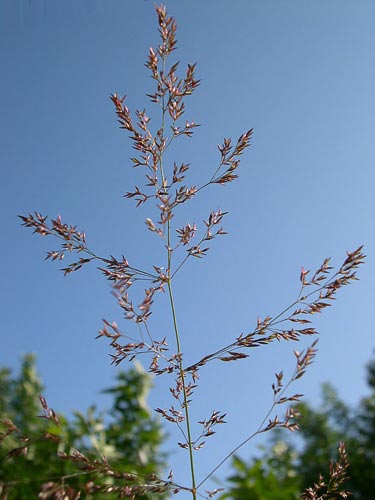Relatives
Agrostis tenuis Sibth. - Colonial bentgrass.
Taxonomic position.
Family Poaceae Barnhart Genera Agrostis L.Synonyms.
A.lithuanica Bess. ex Schult. fil., A. vulgaris With., A. capillaries auct.Morphology and biology.
Perennial, short rhizomatous grass. Height is (10) 30 to 80 cm; forms spongy swords with thin, erect, rising runners. Leaves are 2-20 cm long, 1-4 mm wide, flat or rolled-up, green. Lingula of upper stem leaf is 0.5-1.5(2) mm long, obtuse, with stubby end. Lower leaves infrequently have lingula. Inflorescence is panicle with thin, slightly rough branches, 2 cm to 15 cm long, 2 cm to 6 cm wide. Panicle is sprawling before and after flowering. Spikelet is 1.7-2 cm length. It has one-flower, brownish or violet, with smooth pedicle, usually without awn. Glumes are 1.5-2 mm long, usually brownish-violet. Lower floral glume is a bit shorter and is 2-3 times longer than upper floral glume. Anther is about 1 mm long, yellow or violet. Cross-pollinated, wind-pollinated. Seeds dehisce after maturing. Mass of 1000 seeds is 0.06 g. Flowering: June - August. Seed and vegetative (mainly) reproduction. Chromosomal number 2n=28.Distribution.
European part, except districts around [GaS1]Don and Volga rivers; Caucasia; Western and Eastern Siberia (except Arctic part, eastern border - basin of river Lena); Far East (invasion in Kamchatka, island Sakhalin, Kuril) and Middle Asia (north); Scandinavia, Atlantic and Middle Europe; Mediterranean, Asia Minor, Iran (north); invasive or naturalized in several other temperate countries.Ecology.
Psychromesophyte. Species occurs on upland and flood plain meadows, along pond banks, river sands and shingles, forest openings, along roads. It can grow in all types of soil, but prefers light sandy soil. Species is well developed on peaty soils. It is frost resistant, especially to spring freeze.Economic value.
In soil conditions with good moisture it is used as haying plant; good grazing plant, grows quickly after grazing; is resistant to trampling; is highly palatable to cattle before flowering. It is decorative, used for establishing lawns. Has potential for creating erosion-prevention turf cover.Reference citations:
Cherepanov S.K. 1988. List of Vascular Plants of Russia (Plantae Vasculares Rossicae et Civitatum Collimitanearum (in limics USSR olim)). St. Petersburg: Mir I Semia. 990 pp. (in Russian).Gubanov I.A., Kiseleva K.V., Novikov V.S., Tychomirov V.N. 2002. Illustrated determinant of plants of Middle Russia. Moscow. V.1: 526. (in Russian).
Harkevich S.S., ed. 1982. Wild fodder grass of Far East. Moscow: Nauka. 240 pp. (in Russian).
Tzvelev N.N. 1976. Poaceae USSR. Leningrad: Nauka. 788 pp. (in Russian).


